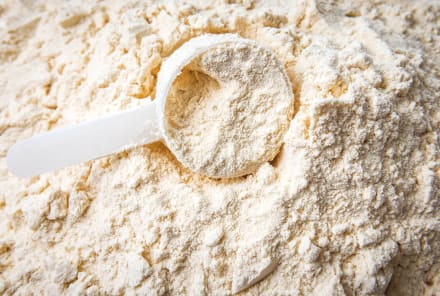Advertisement
How Many Omega-3s Do You Need Per Day? Experts Break It Down


Ashley Jordan Ferira, Ph.D., RDN is Vice President of Scientific Affairs at mindbodygreen. She received her bachelor's degree in Biological Basis of Behavior from the University of Pennsylvania and Ph.D. in Foods and Nutrition from the University of Georgia.
Omega-3 fatty acids are the darlings of the healthy fats world. These polyunsaturated fats have many whole-body health benefits thanks to their antioxidant and anti-inflammatory properties1, support heart health, protect your brain and eyes2, and even help you maintain a balanced mood.*
Of the different omega-3s out there, three are probably the most well-known: EPA (eicosapentaenoic acid), DHA (docosahexaenoic acid), and ALA (alpha-linolenic acid). Each is a little different and has its own unique roles in the body.
And while you're surely no stranger to the fact that getting ample omega-3s is important for maintaining a balance of healthy fats and many aspects of your health and well-being, it's not always quite so clear just how much you need (and of which, in particular) to truly feel your best.
Here's what the latest research and top experts have to say about how much omega-3s to aim for, who might need more than others, and your best options for meeting your needs.
How much omega-3 do most people need?
Though health experts are all on the same page about the fact that omega-3s are incredibly important, the total amount that most people need each day remains a bit of a gray area and personalized decision.
Here's the deal: There is an established daily nutritional requirement (aka adequate intake or "AI") for ALA, the omega-3 you'll find in plant sources like flaxseed, chia seeds, soy, and walnuts. The AI for ALA is 1,100 milligrams per day for adult women and 1,600 milligrams for men each day. For reference, an ounce of walnuts offers 2,600 milligrams.
However, the National Academies' Food and Nutrition Board hasn't created official recommendations for the famed omega-3s EPA and DHA—or a recommendation for the total omega-3s we should consume per day.
This is something experts would like to see change. "While EPA and DHA can be synthesized in the body from dietary sources of ALA, the conversion rate is very low," explains dietitian Maya Feller, M.S., R.D., CDN.
How low? Only about 1 to 21%3 of ALA gets converted to EPA and DHA, with considerable variability between women versus men and as we age. "It would be beneficial to see recommendations for EPA and DHA as well as for ALA as it could encourage a greater diversity of omega-3 rich foods in the standard patterns of eating," concludes Feller.
That said, while no daily nutritional requirements exist (yet), the science has led several other organizations to issue recommendations that certainly inform what our daily EPA and DHA goals should be.
The Dietary Guidelines for Americans suggest that people consume 8 ounces (about two servings) of fish per week. They suggest that this intake is enough to provide what equates to about 250 to 500 milligrams of combined EPA and DHA per day—enough to provide some foundational heart health benefits.* The European Food Safety Authority, also promotes between 250 and 500 milligrams per day of these marine omega-3s EPA and DHA.
Unfortunately, research4 also shows that few people (less than 10% of Americans5) actually meet this simple, baseline benchmark of 500 mg of EPA and DHA, the rough two-fish intake equivalent.
The American Heart Association6 also recommends the general population aim for at least two serving of fish (the fatty, oily variety like anchovies, sardines, salmon, mackerel, etc.) each week, but they also aim to further up your omega-3 game by asserting that 1,000 milligrams (aka 1 gram) or more of EPA plus DHA daily confers greater cardioprotective benefits.*
Board-certified neurologist David Perlmutter, M.D., similarly suggests achieving this loftier level, 800 to 1,200 milligrams of DHA, specifically, per day.
As Ashley Jordan Ferira, Ph.D., RDN, mbg's director of scientific affairs, concludes: "Whether 500 milligrams, 1 gram, or 1.5 grams of daily EPA and DHA, the science-backed consensus of these organizations and healthcare practitioners makes one fact abundantly clear: We have a national omega-3 gap that needs to be addressed asap."
Who needs extra omega-3s?
The initial answer to who needs extra omega-3s is, well, most of us. As Ferira shares, "Americans are only consuming 86 milligrams of this omega-3 duo4 on average each day, and 90% of the nation is failing5 to achieve the 500 milligrams-per-day recommendation."
Research also demonstrates that certain groups of people need to give particular attention to key omega-3s or consume even more than the baseline Dietary Guidelines for Americans recommendation.
Pregnant women, for example, are advised to get at least 200 milligrams of just DHA7 per day (some organizations recommend 300 milligrams) because of the role it plays in fetal development, particularly when it comes to cognition and vision.*
Those with focused heart health needs (e.g., blood pressure and lipids with particular focus on triglycerides), meanwhile, can benefit from anywhere between 500 and 1,800 milligrams of EPA and DHA, along with 1,500 to 3,000 milligrams of ALA per day.*
Echoing these higher omega-3 needs for cardiovascular health, The FDA considers 800 milligrams (or higher) of EPA plus DHA to be an omega-3 level relevant to blood pressure lowering benefits, as well as a reduction in risk for hypertension and coronary heart disease8.†
Ferira puts it this way: "The collective science and consensus for omega-3's positive and holistic benefit on heart health is clear. If more people took advantage of EPA plus DHA each day, the cardiovascular health of our nation would be better for it."*
Can you go overboard on omega-3s?
Of course, it's possible to get too much of any good thing—but clinical research shows that up to 10,000 milligrams (10 grams) of EPA and DHA per day is safe for most people (i.e., as it relates to blood-thinning potential) and likely won't cause any adverse health effects.
Additionally, "there is no established upper limit for omega-3s consumed via food," Feller says. That's true for ALA, EPA and DHA. Ferira adds, "While there's no upper ceiling for omega-3 fats to avoid, I actually wish we had a 'lower limit' for omega-3s where a 'warning' would sound, because that's how little we're consuming as a nation. I'm talking about EPA and DHA specifically."
Since every individual is unique, though, high amounts of omega-3s may affect different people differently. Though to be clear, the amounts of intake we're discussing (i.e., eating a couple of servings of fish per week and taking a daily omega-3 supplement within the recommended dosage) is not going to kick you over any hypothetical limits.
Of course, checking with your healthcare practitioner is always a prudent move before changing up your supplement regimen.
How omega-6s affect our omega-3 needs.
Specific health goals and considerations aren't the only factors that influence how many omega-3s we need. In fact, our intake of another type of fat—omega-6 fatty acids—has a significant impact.
Like omega-3s, omega-6s are a type of polyunsaturated fat. You'll typically find them in vegetable oils (think soybean, corn, canola, etc.), nuts, and seeds. While omega-6 fatty acids are also beneficial (and we have a daily nutritional requirement for the omega-6 linoleic acid, in fact), they can have pro-inflammatory properties when you eat too many, according to Feller.
That's because they convert linoleic acid, an essential fatty acid, into arachidonic acid, which plays a role in modulating inflammatory pathways, she explains. Basically: Omega-6 fatty acids aren't inherently "bad" but become problematic when you overdo them.
And the issue is, most people do overdo it on the omega-6s. Studies9 suggest that a ratio somewhere between 2:1 omega-6s to omega-3s is ideal for health. However, the average American consumes 10 to 20 times as many omega-6s as omega-3s10. Talk about tipping the scales way out of balance.
How is this possible? Mostly because of the overconsumption of processed, packaged and fried foods, which are often laden with omega-6 fatty acids in the form of vegetable oils, such as soybean oil11.
So, how do you tip the scales back in your favor? It's a two-part solution, says integrative dietitian Marisa Moore, RDN, L.D.: Eat more fatty fish and ditch the processed foods and lower-quality vegetable oils.
Ferira adds this expert intel: "Better oil alternatives that are rich in omega-3 and omega-9 fats are avocado oil, EVOO, and flaxseed oil. If it's within your budget, look for the organic varieties."
What to know about omega-3 supplements.
Given how few people consume the recommended two servings of fatty fish per week (again, this is your baseline starting point), omega-3 supplements—especially fish oil supplements—have become popular additions to many a routine.
Keep in mind, though, that you'll want to check the supplement label closely instead of taking the claims on the front of the bottle at face value, says Feller. The reason: While an omega-3 supplement may boast that it contains 500 or 1,000 (or higher) milligrams of fish oil on the front label, that overall input does not tell you how much omega-3s EPA and/or DHA you're getting.
In fact, the amount of actual EPA and/or DHA in a product is much lower—and you'll have to scan the ingredient breakdown on the supplement facts panel to know for sure. Ferira explains you'll want to "turn the bottle over and do some quick math. The variable to solve for is X. EPA + DHA = X."
"Formulations vary widely, so it's important to find a supplement that is transparent and lists the breakdown on the nutrition facts label," Feller notes. You'll also want to check a product's serving size; otherwise, you might unintentionally take more or less omega-3s than you realize day after day.
Nutrition scientist Ferira puts it this way, "In the case of fish oil supplements, EPA and DHA are the bioactives—the biologically active ingredients—so that total is the number to care about, and a high-quality supplement will make this amount abundantly clear on their packaging. If it's unclear, move on, because that's just plain fishy."
In addition to dose (or potency), Ferira also recommends prioritizing an omega-3 supplement that optimize these features: "You'll want to look for high quality (e.g., low oxidation parameters and top-notch purity, particularly as it relates to heavy metals and other environmental contaminants), a premium source (look for sustainably sourced, cold-water, wild-caught fish), and the best form (triglyceride is the most bioavailable)."
Finally, while fish oil supplements can certainly be high-quality tools for boosting omega-3 intake, you're not up a creek without a paddle if you follow a strict vegan or vegetarian diet or have a fish allergy that makes taking fish oil a nonstarter.
In this case, Moore recommends trying an algae-based (algal oil) omega-3 supplement. Microalgae, she says, is the primary food source for most fish (they have to get their omega-3s from somewhere!) and can be a significant source of omega-3s, particularly DHA (caveat: they are lower on the EPA front).* Read more about finding a quality fish oil supplement here.
The bottom line.
Unlike many of the other key nutrients our bodies need to function optimally, there's a bit of gray area when it comes to certain omega-3s since the National Academies hasn't issued a daily nutritional requirement for EPA and DHA (yet).
Don't let that stop you from striving for a science-backed level of these powerhouse, heart-essential lipids. Per experts and the collective scientific literature, we need a minimum of 500 milligrams of EPA and DHA each day, plus 1,100 to 1,600 milligrams of ALA.
Accomplishing that 500 milligram minimum through diet requires eating two servings of fish per week and incorporating ALA sources like walnuts and flaxseeds into your daily snacks and meals. In addition to diet, a targeted omega-3 supplement made from fish oil or algae is a useful strategy to achieve a balanced and health omega-3 status throughout life.*
And since many people may benefit from increased omega-3 intake, it's important to check in with your health care provider about how many omega-3s you should strive for on a daily basis. In many of these cases, a high-quality supplement (like mbg's omega-3 potency+) might be the daily essential you've been looking for.
11 Sources
- https://www.ncbi.nlm.nih.gov/pmc/articles/PMC3257651/
- https://www.ncbi.nlm.nih.gov/pmc/articles/PMC7230711/
- https://academic.oup.com/ajcn/article/83/6/1467S/4633217
- https://www.ncbi.nlm.nih.gov/pmc/articles/PMC3992162/
- https://pubmed.ncbi.nlm.nih.gov/28956299/
- https://www.heart.org/en/healthy-living/healthy-eating/eat-smart/fats/fish-and-omega-3-fatty-acids
- https://pubmed.ncbi.nlm.nih.gov/18184094/
- https://www.fda.gov/food/cfsan-constituent-updates/fda-announces-new-qualified-health-claims-epa-and-dha-omega-3-consumption-and-risk-hypertension-and
- https://www.ncbi.nlm.nih.gov/pmc/articles/PMC533861/
- https://www.ncbi.nlm.nih.gov/pmc/articles/PMC3335257/
- https://pubmed.ncbi.nlm.nih.gov/21367944/
Watch Next
Enjoy some of our favorite clips from classes
Enjoy some of our favorite clips from classes
What Is Meditation?
Mindfulness/Spirituality | Light Watkins
Box Breathing
Mindfulness/Spirituality | Gwen Dittmar
What Breathwork Can Address
Mindfulness/Spirituality | Gwen Dittmar
The 8 Limbs of Yoga - What is Asana?
Yoga | Caley Alyssa
Two Standing Postures to Open Up Tight Hips
Yoga | Caley Alyssa
How Plants Can Optimize Athletic Performance
Nutrition | Rich Roll
What to Eat Before a Workout
Nutrition | Rich Roll
How Ayurveda Helps Us Navigate Modern Life
Nutrition | Sahara Rose
Messages About Love & Relationships
Love & Relationships | Esther Perel
Love Languages
Love & Relationships | Esther Perel

















